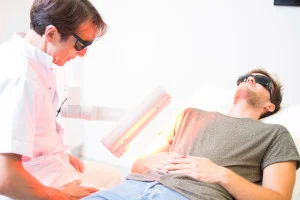Photodynamic therapy (PDT)
 Photodynamic therapy is a method of treating localised skin abnormalities and cancers. The treatment consists of applying a special cream, Metvix, to the skin growth and 4 to 6 hours later shining a pure red light on it. The cream contains methyl aminolevulinate, which becomes active when exposed to light of a certain wavelength. This substance makes abnormal skin cells extra sensitive to light.
Photodynamic therapy is a method of treating localised skin abnormalities and cancers. The treatment consists of applying a special cream, Metvix, to the skin growth and 4 to 6 hours later shining a pure red light on it. The cream contains methyl aminolevulinate, which becomes active when exposed to light of a certain wavelength. This substance makes abnormal skin cells extra sensitive to light.
When do we use PDT?
PDT can be used to treat certain types of skin cancer and pre-cancerous cells:
- Basal cell carcinoma (BCC), particularly the superficial variant
- Bowen’s disease (BD)
- Actinic keratosis (AK)
This therapy has the advantage that large skin areas can be treated without surgery. Moreover, the treatment reduces the risk of scarring.
Frequently Asked Questions about Photodynamic Therapy (PDT)
What are the benefits of photodynamic therapy?
A key advantage of photodynamic therapy is that abnormal skin cells can be treated without the need for surgery, which helps reduce the risk of scarring. In addition, multiple or larger skin areas can often be treated in a single session. This makes PDT particularly suitable for superficial skin abnormalities or sun-damaged areas.
Is PDT a painful treatment?
Some patients experience a burning, stinging or warm sensation during the light exposure. The intensity of this varies depending on the area being treated and individual sensitivity. Most people tolerate the procedure well. Your dermatologist will guide you through the process and explain what to expect before the session begins.
What is the recovery like after photodynamic therapy?
After the treatment, the skin may be red, tender or swollen. It is also common to experience flaking, scabbing or mild peeling as the skin heals. Recovery time can range from a few days to a couple of weeks. It is important to avoid sun exposure and follow the aftercare instructions provided by your dermatologist to allow proper healing.
How do I know if photodynamic therapy is right for me?
Whether PDT is an appropriate treatment depends on factors such as the type of skin condition, your skin type, medical history, and any previous treatments. The dermatologist will assess your situation during a consultation and discuss whether photodynamic therapy is a safe and suitable option for you.
Waiting time indication
Dermatology
Days
Gynaecology
Days
Proctology
Days
Phlebology
Days
Plastic surgery
Days




